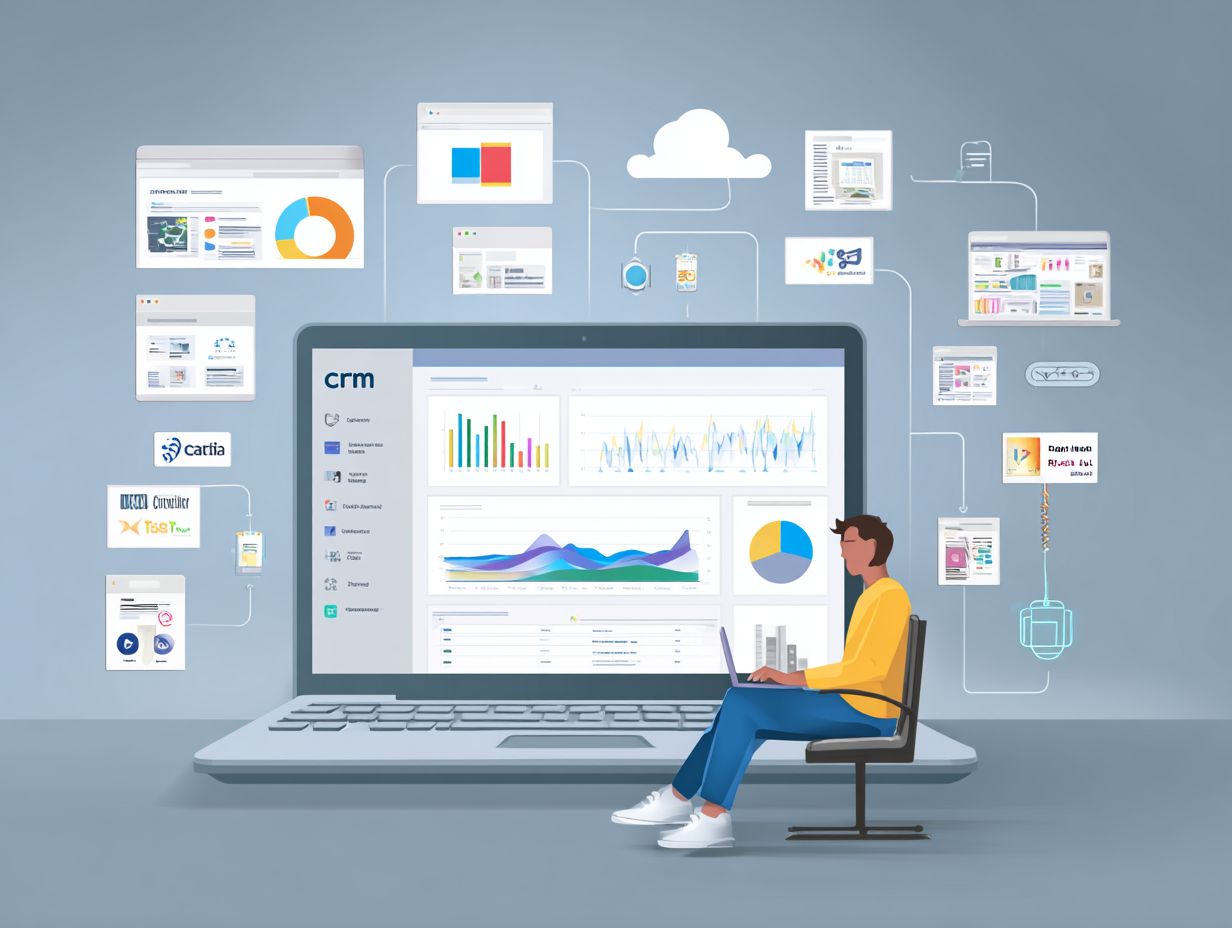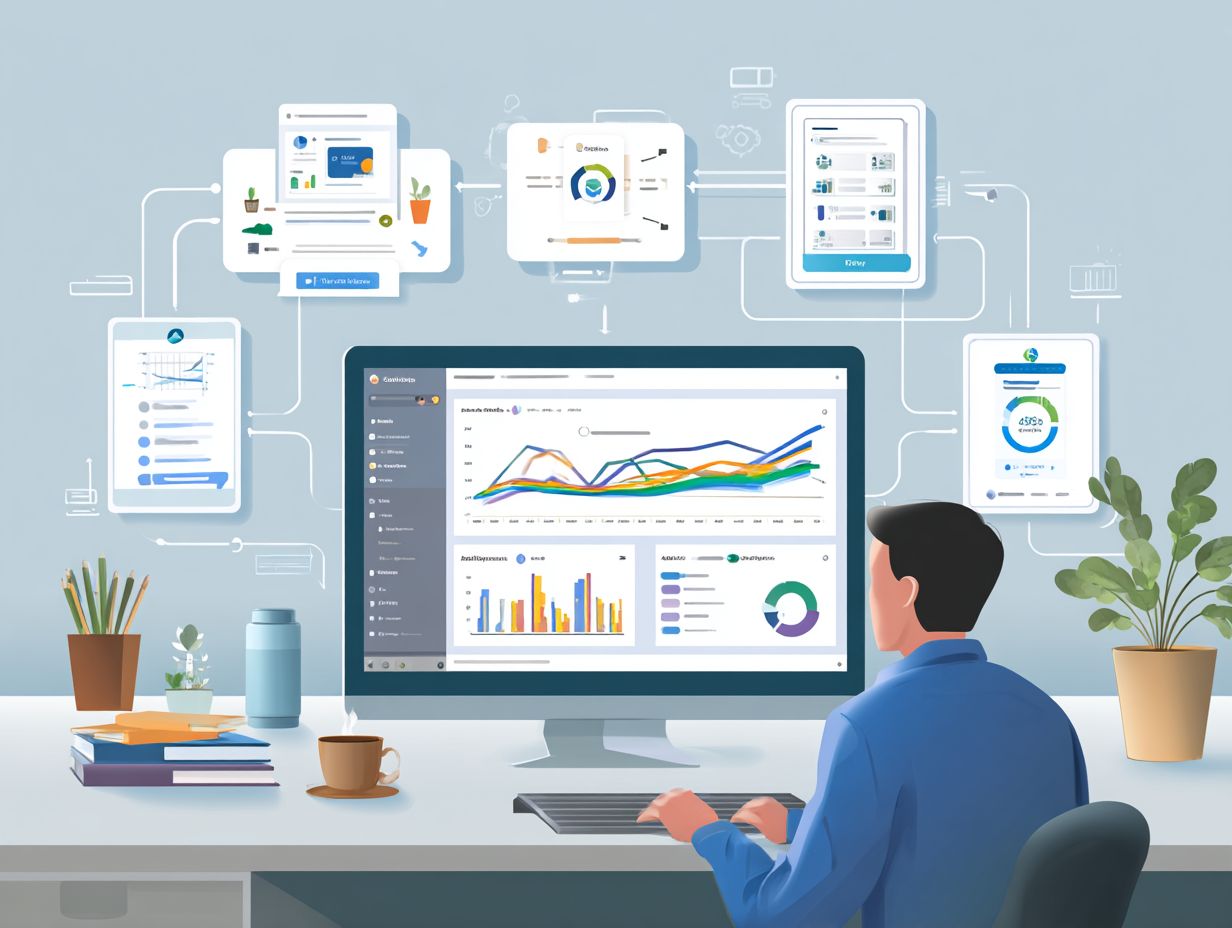CRM Data Integration: Steps, Tools, and Best Practices
In the current market, effectively merging CRM data is essential for obtaining key details about customers. By smoothly linking your data systems, both the sales and marketing teams can work together more effectively, leading to growth and improving customer relationships.
This article will show you the important steps, necessary tools, and best practices for successful CRM integration, helping your organization make the most of its customer data.
Key Takeaways:
- Linking CRM data properly is important for businesses to make better decisions and improve the customer experience.
- Key steps for successful integration include assessing current data systems, defining integration goals, and choosing the right approach.
- Data quality management and ensuring security and compliance are important best practices for successful CRM data integration.
Importance of Data Integration

Data integration allows businesses to consolidate customer data, leading to operational efficiencies and improved customer relationships. By using combined data systems, companies can improve their analytical CRM features, leading to better knowledge of customer actions.
For example, tools like Salesforce or HubSpot enable businesses to segment customers based on demographics, purchase history, and engagement levels. This allows marketing campaigns to be customized for particular user groups.
Data indicates that businesses using these methods can increase how much a customer spends over their entire relationship by as much as 30%. Implementing these systems might require an initial investment but can yield significant long-term returns through increased retention and satisfaction. This approach aligns with the principles outlined in our analysis of boosting sales and retention with effective customer experience marketing.
Challenges in Data Integration
Despite its benefits, data integration presents challenges such as data quality issues and governance concerns that can hinder effective use.
To address these challenges, start by adopting tools like Talend for data profiling, which can help identify inconsistencies and data quality problems across databases.
It is important to set up rules for managing data. Consider using role-based access controls to maintain data accuracy. Regular data audits can spot issues early on.
For example, setting up monthly review meetings with your data management team can create accountability and maintain high standards of data accuracy. This proactive approach helps reduce risks and improves decisions based on data.
Steps for Effective CRM Data Integration
Implementing a good CRM data integration plan involves a set of careful steps that make sure data is correctly and smoothly linked. To enhance this process, it’s important to consider how technology can play a role in improving customer interactions. Customer experience and technology can revolutionize the way data integration is approached, ensuring a more seamless and effective outcome.
1. Assessment of Current Data Systems
Start your integration by carefully reviewing current data systems to find their strengths and weaknesses. Start by evaluating factors like data accuracy, existing integrations, and user adoption rates. Create a checklist that includes:
- Assess the accuracy of existing data inputs-review samples for discrepancies;
- Identify current system integrations-list platforms, such as CRM or ERP systems;
- Analyze user feedback to gauge adoption-consider surveys or interviews.
Tools like Google Data Studio can reveal gaps in data, making it simpler to share findings with those involved and determine areas that require improvement. This structured approach lays the groundwork for a successful integration strategy.
2. Defining Integration Goals
Clearly defined integration goals are essential for guiding the entire process and ensuring alignment with business objectives.
Start by identifying specific outcomes you want to achieve, such as improving data accessibility by 40% or reducing response times by 25%. Utilize SMART criteria to ensure these goals are specific, measurable, achievable, relevant, and time-bound.
For example, if you want to improve customer support, set a goal to lower the average time to resolve a ticket from 12 hours to 8 hours in three months. Regularly review progress and adjust strategies as needed to stay on track with these objectives.
3. Choosing the Right Integration Approach

Selecting the appropriate integration approach-API versus ETL-can significantly impact the success of your CRM strategy.
API integrations, such as those offered by Zapier, provide real-time data access and are often more flexible, allowing for quick adjustments to data flows. They can incur higher costs as usage scales.
On the other hand, ETL tools like Informatica work well with large amounts of data, making them a budget-friendly choice for managing big data sets. However, they have delays that can slow down immediate decision-making. When choosing, consider your budget, desired data freshness, and the complexity of your data environment.
Tools for CRM Data Integration
There are many tools available to help with CRM data integration, each with specific features for different business needs. Those interested in how technology can enhance customer interactions might find our insights on Customer Experience and Technology particularly enlightening.
1. Popular CRM Integration Tools
Popular CRM integration tools provide effective solutions for consolidating data across platforms, enhancing user experience and operational efficiency.
Among the top contenders, DCKAP stands out for its seamless e-commerce integration, allowing businesses to sync data from various sales channels effortlessly.
HubSpot excels in marketing automation, facilitating lead tracking and email marketing campaigns through a user-friendly interface. At the same time, Salesforce offers a full CRM tool with thorough analytics and flexible customization options, suitable for businesses of any size.
Each tool boasts unique integration capabilities, so consider your specific business needs and existing technology stack to choose the right fit.
2. Custom vs. Pre-built Solutions
Choosing between custom and pre-built integration solutions depends on your business’s unique needs, budget, and scalability requirements.
Custom integration solutions provide great flexibility and can be specifically designed to fit your organization’s processes and needs.
For instance, a logistics company might build a specialized system connecting their inventory management software with shipping platforms. On the other hand, ready-made tools like Zapier or Integromat allow small businesses to set up and run basic tasks quickly and affordably.
A marketing firm, for example, could use Zapier to link their email marketing tools and CRM within a few hours, saving time and resources. In the end, your decision should match your long-term objectives.
Best Practices for CRM Data Integration
Applying effective techniques for combining CRM data ensures data remains correct and complies with security standards, creating confidence in the handling of customer information.
1. Data Quality Management

Making sure data is correct in CRM integration stops mistakes and helps with making decisions. To achieve high data quality, start by implementing data cleansing techniques using tools like Informatica, which allow you to standardize, deduplicate, and validate data.
Profiling enables you to assess data integrity and identify inconsistencies before integration. For example, regular checks can lead to a 30% increase in data accuracy, directly impacting customer targeting effectiveness.
Consider establishing a routine data review process involving stakeholders to maintain ongoing data quality. This continuous method keeps your CRM dependable, leading to better customer connections and successful business plans.
2. Security and Compliance Considerations
Data security and compliance with regulations such as GDPR are critical aspects of CRM data integration that cannot be overlooked.
Organizations should put in place a strong system to manage their data properly and meet rules. This includes regular security audits using tools like OneTrust, which helps manage compliance requirements effectively.
Teaching your team the best ways to protect data privacy is essential. For instance, establish protocols for handling personal data, such as minimizing unnecessary data collection and ensuring data is encrypted during transfers.
Performing audits twice a year finds weaknesses and strengthens compliance throughout the company, protecting customers’ private information.
3. Future Trends in CRM Data Integration
New developments like artificial intelligence and machine learning are expected to change how CRM data integration works, offering better information from customer data. AI tools like Salesforce Einstein and HubSpot’s CRM use machine learning algorithms to analyze customer interactions in real time.
For instance, Salesforce Einstein can predict sales opportunities based on past customer behavior, allowing businesses to tailor their approaches.
HubSpot automatically collects information from emails and interactions, simplifying the process of monitoring customer activities. With these tools, businesses can develop targeted marketing strategies that increase engagement, leading to higher customer satisfaction and loyalty.
Frequently Asked Questions
1. What is CRM Data Integration?
CRM Data Integration is the process of combining customer relationship management (CRM) data from various sources and systems into a single, unified platform. It gives businesses full information about their customers, helping them make better choices and improve customer service.
2. What are the steps involved in CRM Data Integration?
The process of combining CRM data usually involves mapping the data, pulling out data, cleaning the data, changing the data format, loading the data, and checking the data for errors. These steps make sure the data is correctly moved and added to the CRM system.
3. What are some essential tools for CRM Data Integration?
There are different tools for working with CRM data, such as ETL (Extract, Transform, Load) tools, data transfer tools, platforms for merging data, and API integration tools. These tools simplify the integration process and keep the data consistent and correct.
4. What are the best practices for CRM Data Integration?
Some of the best practices for CRM Data Integration include defining a clear integration strategy, involving key stakeholders, ensuring data quality and governance, testing and validation of data, and regularly monitoring and maintaining the integrated data.
5. Why is CRM Data Integration important?
Combining CRM information is important for companies because it brings together various data sources. This gives a complete view of customer details, helping businesses easily find patterns and trends. It also improves the overall efficiency and effectiveness of the CRM system.
6. What are the benefits of CRM Data Integration?
CRM Data Integration offers several benefits, including more accurate and consistent data, better understanding of customer details and categorization, improved decision-making, higher efficiency, and reduced costs. It also leads to a better customer experience and helps in building stronger customer relationships.





